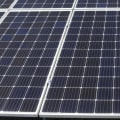The most powerful solar panels · How to choose quality solar energy. Currently, the most efficient solar panels available on the market are approximately 23 percent efficient. More specifically, SunPower's high-efficiency solar panels are recognized as the most efficient solar panels available, with a 22.8 percent rating. Other manufacturers that make some of the most efficient solar panels include LG (22 percent) and REC Solar (21.7 percent).
Department of Energy's National Renewable Energy Laboratory (NREL) created solar cell with record 39.5% efficiency under global 1-sun illumination. This is the most efficient solar cell of any type, measured under standard conditions of 1 sun. Details of the development are described in the article “Triple-junction solar cells with 39.5% terrestrial and 34.2% spatial efficiency enabled by thick quantum well supergrids, which appears in the May issue of Joule magazine. The improvement in efficiency followed research into “quantum well” solar cells, which use many very thin layers to modify the properties of solar cells.
Scientists developed a quantum well solar cell with unprecedented performance and implemented it in a device with three junctions with different bandgap, where each junction is adjusted to capture and use a different portion of the solar spectrum. Materials III-V, so called because of their position on the periodic table, cover a wide range of energy bandgap that allow them to target different parts of the solar spectrum. The upper junction is made of indium gallium phosphide (GaInP), half of the gallium arsenide (GaAs) with quantum wells and the lower part of indium gallium arsenide (GaAs) mismatched in the network. Each material has been greatly optimized through decades of research.
Scientists used quantum wells in the middle layer to extend the GaAs cell's band gap and increase the amount of light the cell can absorb. Importantly, they developed optically thick quantum well devices without significant voltage loss. They also learned how to hybridize the upper GaINP cell during the growth process to improve its performance and how to minimize the threading dislocation density in GAINA with network mismatch, discussed in separate publications. Together, these three materials inform the cell's novel design.
III-V cells are known for their high efficiency, but the manufacturing process has traditionally been expensive. Until now, III-V cells have been used to power applications such as space satellites, unmanned aerial vehicles and other niche applications. NREL researchers have been working to drastically reduce the cost of manufacturing III-V cells and provide alternative cell designs, which will make these cells economical for a variety of new applications. The new III-V cell was also tested for efficiency in space applications, especially for communications satellites, which run on solar cells and for which high cell efficiency is crucial, reaching 34.2% for an early-life measurement.
The current cell design is suitable for low radiation environments, and higher radiation applications can be allowed by further development of the cell structure. SunPower produces some of the best high-efficiency solar panels on the market today. Although their panels have the highest price of all the panels in our review, an initial investment in the top solar panels will result in future long-term savings. Hyundai, a large solar panel manufacturer based in South Korea, offering a range of high-end panels based on exclusive tile cell technology.
So, while monocrystalline panels are more expensive, their higher efficiency rate means you can reduce installation, labor, and material costs compared to buying cheaper but less efficient polycrystalline panels. REC is a leading innovator in solar cell technology and is developing ultra-efficient heterojunction cells that are the basis of the high-performance Alpha panel series. Homeowners looking for solar panels that offer a more economical price but high quality performance should look for Q Cells. Solar panel power vs.
temperature comparison chart for various cell types: Note that the cell (panel) temperature is usually 20 to 30 degrees C above ambient air temperature. The efficiency of solar panels is a useful metric that acts as a calculator to deduce how much energy a solar panel generates compared to other products. Rain doesn't affect the efficiency of your solar panel; however, rain clouds could affect the amount of sun that reaches them. For those looking for the most efficient solar panels for their solar energy system, the first thing to know is how to compare efficiency metrics for different brands of manufacturers.
A simple way to answer “How many solar panels do I need is to let a local solar installer check your home and give you a quote for system size (including number and power of panels), cost, and estimated annual and lifetime savings. The half-cut cell configuration is slightly more efficient, since the panel voltage is the same, but the current is divided between the two halves. This strong and durable solar panel is rated for a snow load of up to 5400 Pa and a wind load of up to 2400 Pa. The efficiency of solar cells is equal to the percentage of sunlight that shines in each cell that is converted to electricity.
For example, you can buy several monocrystalline panels, but the design of each panel can cause a decrease in efficiency if they are not designed to work together. For example, if the sun shines on a high-efficiency solar panel with a 20 percent rating, 20 percent of the sun's energy will be converted to solar energy. . .







